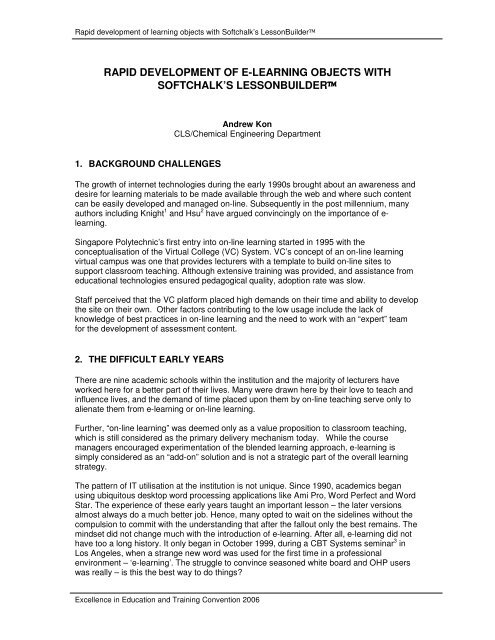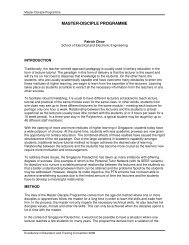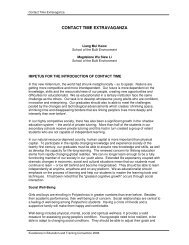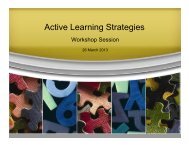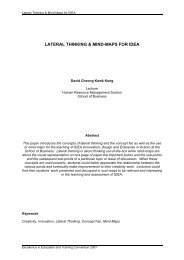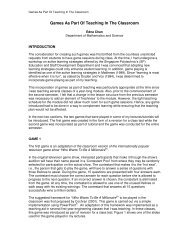Download Full Paper - Singapore Polytechnic
Download Full Paper - Singapore Polytechnic
Download Full Paper - Singapore Polytechnic
You also want an ePaper? Increase the reach of your titles
YUMPU automatically turns print PDFs into web optimized ePapers that Google loves.
Rapid development of learning objects with Softchalk’s LessonBuilderRAPID DEVELOPMENT OF E-LEARNING OBJECTS WITHSOFTCHALK’S LESSONBUILDERAndrew KonCLS/Chemical Engineering Department1. BACKGROUND CHALLENGESThe growth of internet technologies during the early 1990s brought about an awareness anddesire for learning materials to be made available through the web and where such contentcan be easily developed and managed on-line. Subsequently in the post millennium, manyauthors including Knight 1 and Hsu 2 have argued convincingly on the importance of e-learning.<strong>Singapore</strong> <strong>Polytechnic</strong>’s first entry into on-line learning started in 1995 with theconceptualisation of the Virtual College (VC) System. VC’s concept of an on-line learningvirtual campus was one that provides lecturers with a template to build on-line sites tosupport classroom teaching. Although extensive training was provided, and assistance fromeducational technologies ensured pedagogical quality, adoption rate was slow.Staff perceived that the VC platform placed high demands on their time and ability to developthe site on their own. Other factors contributing to the low usage include the lack ofknowledge of best practices in on-line learning and the need to work with an “expert” teamfor the development of assessment content.2. THE DIFFICULT EARLY YEARSThere are nine academic schools within the institution and the majority of lecturers haveworked here for a better part of their lives. Many were drawn here by their love to teach andinfluence lives, and the demand of time placed upon them by on-line teaching serve only toalienate them from e-learning or on-line learning.Further, “on-line learning” was deemed only as a value proposition to classroom teaching,which is still considered as the primary delivery mechanism today. While the coursemanagers encouraged experimentation of the blended learning approach, e-learning issimply considered as an “add-on” solution and is not a strategic part of the overall learningstrategy.The pattern of IT utilisation at the institution is not unique. Since 1990, academics beganusing ubiquitous desktop word processing applications like Ami Pro, Word Perfect and WordStar. The experience of these early years taught an important lesson – the later versionsalmost always do a much better job. Hence, many opted to wait on the sidelines without thecompulsion to commit with the understanding that after the fallout only the best remains. Themindset did not change much with the introduction of e-learning. After all, e-learning did nothave too a long history. It only began in October 1999, during a CBT Systems seminar 3 inLos Angeles, when a strange new word was used for the first time in a professionalenvironment – ‘e-learning’. The struggle to convince seasoned white board and OHP userswas really – is this the best way to do things?Excellence in Education and Training Convention 2006
Rapid development of learning objects with Softchalk’s LessonBuilderA few years after the introduction of the VC platform, a small team of staff, at the institution,came together to explore interactive learning technologies on the web. Answers were soughtto questions on whether there was a more effective way to cultivate and nurture effectivelearning in an on-line learning environment. When Blackboard was piloted in one of theacademic schools, many were pleased as it enabled and empowered them to develop anddeliver an on-line course easily. The Blackboard Learning Management System was used tocomplement and supplement traditional learning initiatives. The system has utilities forcontent management, assessment, grade book, collaboration and communication. Thisprovides a lot of flexibility and creativity for the faculty to teach both in and out of theclassroom.The triumph of Blackboard as a learning management system over VC underscores theimportance of ease of use, full feature, functionality and support pedagogy to ensure widespread use and adoption. In a survey done by the institution, over a period of 2 years, thenumber of course sites grew from 700 to 1250. All this underscores the importance ofsimplicity, ease of use and versatility over perceived benefits relating to the latest trend intechnology.In a way, the success of Blackboard as a learning management system paves the way forthe introduction of more IT technologies to education at the institution. More and moreacademics at the institution begin to see the virtue of such an endeavour.3. TRAVERSING THE CHASMWe now examine how the institution traversed the e-learning chasm. The first step we took toachieve e-learning adoption in SP was to gather all e-learning champions in each faculty anddepartment to formulate and drive the e-learning initiatives on campus. The managementrecognises that ILTNET promotes “adhocracy” at work, and that it has been instrumental increating innovative measures to enhance course-sites.The following were some initiatives attributed to ILTNET: The development of Rubrics for benchmarking the quality of course-sites. Pushing for Certification in basic IT competency Providing regular drop-ins and training sessions on the learning management system Conducting rich media training Investigating innovative learning techniques, e.g. the use of Personal DigitalAssistants (PDA) and tablet PCs in a classroom teaching environment Building On-line Learning Communities Forming an ILTNET Support team to carry out operational activities of ILTNET suchas helpdesk and system support Suggesting and evaluating interactive learning technological tools and software – e.g.Softchalk’s LessonBuilderWe will examine the impact of introducing LessonBuilder as a means to build rapidlylearning objects (RLO) for a web based learning environment in the following sections.4. LESSONBUILDER at SINGAPORE POLYTECHNIC4.1 RLOs the way to go?Excellence in Education and Training Convention 2006
Rapid development of learning objects with Softchalk’s LessonBuilderThe idea of building rapid learning content or objects has been widely discussed 4 and thebenefits argued by many experts in this field all point to the savings in cost and time overtraditional waterfall approach.In the waterfall approach, subject matter experts pass on information to the instructionaldesigner who, in turn, designs the solution. A developer then builds the interactive solutionbased on this design, and the quality assurance team tests the solution against the designand test plan. The same has happened at <strong>Singapore</strong> <strong>Polytechnic</strong> with the VC experiment.The development was taking too much effort and time for lecturers to put teaching materialson-line. The impetus to develop rapid learning content was given an additional boost with theSARs crisis. One morning, everybody woke up to the realisation that schools may be shutdown for prolonged periods of time; and face-to-face contact discouraged. The further threatof avian bird flu sealed the importance of using on-line learning to complement, supplementor even replace short term face to face teaching.4.2 The case for Lesson Builder as tool for RLOSoftchalk’s LessonBuilder is an immensely powerful and yet easy to use html editor. Itallows a relatively inexperienced, unsophisticated, entry level user to easily createinteresting, interactive and engaging web lessons.We first saw Softchalk at the Blackboard conference in March 2004 in Phoenix, Arizona. Thefirst version showed great promise in helping “non-techies” create impressive web lessonsthrough the use of text pop-ups, annotations and simple self-assessment quizzes.<strong>Singapore</strong> <strong>Polytechnic</strong> first encounter with Softchalk began sometime in early 2004 when astandalone student project was using LessonBuilder version 1 to convert lecture notes toweb lessons. The project was not too much of a success as the initial version lackedsophistication, and the students who did the project lacked understanding of fundamental ITliteracy. The project almost went under if not for the generous gesture from Softchalk ingiving all version 1 license holders a free upgrade to version 2.LessonBuilderversion 2 was a drastic improvement over her predecessor. There weremarked improvements especially in templates that improved the look and feel of the finalproduct. With the same trademark ease of use as the earlier version, LessonBuilderversion 2 came with improved tools that allowed the user to insert graphics, voice, animation,simple games (e.g. cross word puzzles, drag and drop, matching).The project revived under the hands of a more IT savvy lecturer, and the lessons that werere-built using version 2 were so well received that it caught the attention of many strugglingwith developing web lessons using more traditional html editors like Macromedia’s FrontPage or Dreamweaver. Even the older and not so IT savvy lecturers - we suspect there weremany of them at the institution and elsewhere – also jumped on the bandwagon, driven on bythe need to develop on-line lessons without the hassle of spending huge amounts of time inlearning more powerful editors. Admittedly, these more sophisticated html editors gave morein terms of flexibility and power, but not all appreciated them over the need to spendinordinate amounts of time to get them to work in the first place. Most academics preferspending more time with their charges than poring over unwieldy software codes andinstructions.Then came the time when the institution conducted a first ever e-learning week in December2005 and LessonBuilder rolled out just weeks before the event took place. With a fewquickly put in place mass briefing sessions, many lecturers were able to put together for thefirst time a web enabled lesson almost “overnight”.Excellence in Education and Training Convention 2006
Rapid development of learning objects with Softchalk’s LessonBuilderIn the next section I will identify why LessonBuilder was such a success at the institution.5. LESSONBUILDER 5 FUNDAMENTALS“If you can use a word-processing program, you can use LessonBuilder” – is the claim onthe front page of Softchalk website. There is basically no necessity to know programming orhtml codes. This is essentially the reason why many users find it useful 6 . The only caveat isthe first time installation needed to get LessonBuilder onto the desktop. The reason for thecomplication arises out of the fact that LessonBuilder runs on Java technology. One has toovercome the fear of installing Java based components. Thereafter, everything is a breeze,almost.The LessonBuilder first page interface opens onto a blank page that looks similar to mostword processing programs. See Figure 1. The tool bar at the top of the page is a no frillseasy navigation bar that list all the features within the package. It embodies the “what yousee is what you get” concept and there are no hidden features in the background that theuser need to know to get it to work.Basic text editing is simple and easily accomplished with most users importing their standardword document (or Power point) directly into the blank area through a cut-and-paste action.Pictures (standard formats like gif, jpg and png) and audio (including wav, au, ram, aiff andmp3 formats) files are inserted through an “Insert” link provided by the tool bar which dropsdown to reveal one of the many options available. See Figure 2.Figure 1: Blank PageFigure 2: Drop down editing tool barAmong the many features within LessonBuilder, the text popper ranks as a top favourite. Itgives the lesson a less cluttered look by hiding wordy explanations which reveals only when“moused-over”. See Figure 3.Multiple pages creation within the web site is added through the use of a drop down menuinstruction line for page break. The software automatically creates a menu (at the top andside) that allows the end-user to navigate effortlessly through multiple pages within the website.As an html editor, the Lesson Builder has several disadvantages. It cannot insert tableseasily. There are also several tricky steps to take if you want to insert a mathematicalequation. While not perfect, the software does the job reasonably well.Excellence in Education and Training Convention 2006
Rapid development of learning objects with Softchalk’s LessonBuilderFigure 3: Text PopperFigure 4: Sample QuizStyle in LessonBuilder refers to the final overall look and feel that the web lesson takes onwhen everything is completed. Here, the user selects from a standard template of sevendifferent images on a six colour palette. For the more IT savvy, there is an alternate pathwaywhere their files can be exported to html editors and more sophistication added before beingre-imported back to Lesson Builder. But our experience at the institution shows that mostusers tend to stick to the prescribed features.Figure 5: Style PropertiesOnce satisfied with the effort, users have the option to preview his work before exportingthem out according to a series of well defined format (zip, SCORM or folder). These can thenbe uploaded onto Learning Management systems like Blackboard and WebCity with ease.Excellence in Education and Training Convention 2006
Rapid development of learning objects with Softchalk’s LessonBuilder6. REUSABLE LEARNING OBJECTS (RLO) with LESSONBUILDERThough not very apparent initially, the LessonBuilder can be used to create reusablelearning objects, which can then be reused in many different ways. It could either be re-usedas a standalone object or embedded into other programs/lessons. The following are some ofthe possibilities.6.1 Interactive Quiz questionsThere are six types of interactive quiz questions available ranging from true-false, multiplechoice, multiple answer, short answer, ordering and matching. Through SCORM compliance,the results of the quizzes can be sent directly to grade book of Learning ManagementSystems that are SCORM compliant. See Figure 4.6.2 Interactive Games and ActivitiesThere are four types of activities here – flash card, matching, ordering and word search.Once developed, these learning objects can be saved and filed away in a common pool thatcan be shared by many lecturers.6.3 Other Reusable Learning Objects ToolsAny discussion of RLOs would be incomplete without reference to other tools. Here, we wishto highlight some generic ones as well as those that we use here at the institution.Generic RLO tools on the market generally include Macromedia Breeze, Articulate, Lersus,SNAP! Studio, Content Point, Webex, and Mindflash. These tools usually leverage on somecommon learning management systems and like Lesson Builder make use of industrystandards to allow the RLOs portability. Standards include SCORM and AICC compliance.Among those used at the institution are Macromedia Breeze and Articulate. Both leverage onMicrosoft’s PowerPoint as its main development tool, besides offering the additional benefitsof easy audio tracking. Audio components can be easily added by standard desktopmicrophone accessories, thereby saving on time and cost in traditional audio recordingsessions.Some other standard features of RLOs include capabilities in building assessment and theability to send the output to Flash, XML tags - which enables content to be indexed and fullysearchable.7. MOVING ONThe story of LessonBuilder is slowly being unfolded not only at the institution but elsewhereacross communities where teaching and learning take place. The progress made intechnology has finally enabled the teacher to do what he does best. With less emphasis onthe technology aspect, e-learning or on-line learning has moved from being a valueproposition, or add on solution, to become an integral part of the repertoire of tools that ateacher can use. In a sense, we see the development over the past decade – from the falloutfrom the word processor war – that for any tool to have mass appeal, it has to satisfy thecriteria of ease of use, full features, flexible, multi-platform, shareable, repeatable orreproducible.Excellence in Education and Training Convention 2006
Rapid development of learning objects with Softchalk’s LessonBuilder8. REFERENCES:1. J. Knight, (2003) Why is e-learning important. [on-line] Available:http://www.janeknight.com/articles/whye-learning.htm2. C. Hsu, (2005) Continuing school after Katrina. [on-line] Available:http://www.usnews.com/usnews/edu/e-learning/articles/1007katrina.htm3. L. Ritzel, (2002). e-Learning is Learning. [on-line] Available: www.prasena.com/public/elearningis Learning.doc4. D. Archibald, (2005). Rapid E-Learning: A Growing Trend. [on-line] Available:http://learningcircuits.org/2005/jan2005/archibald.htm5. Softchalk, (2006). Lesson Builder Data Sheet [on-line] Available:http://www.softchalk.com/pdf/LessonBuilderDataSheet2.pdf6. L. Mitchell, Wow! Lesson Builder! [on-line] Available:http://connect.educause.edu/blog/lorbethm/wow_lessonbuilder/1685Excellence in Education and Training Convention 2006


